|
Limitar tu búsqueda
[+–] Compilador o editor
[+–] Editorial
[+–] Fecha
[+–] Formato
[+–] Idioma
[+–] Tipo de documento
[+–] Tipo de recurso
|

|
|
Sistemas de Seguro por desempleo en el Uruguay
Estudio que expone los sistemas de seguro por paro con los que cuenta Uruguay, resaltando aspectos claves a tomar en cuenta para un análisis completo, como son el contexto legislativo en el que se encuentran insertos tales sistemas, quienes tienen derecho a los seguros, los requisitos para ejercer el derecho al seguro, los montos de seguro que a los que se tiene derecho según sea el caso, los...
|
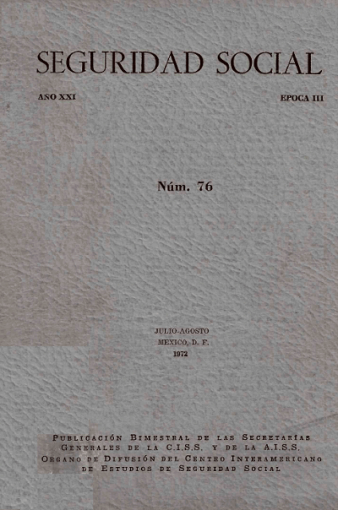
|
|
|
|

|
|
Trabajo
Este documento forma parte de la serie de manuales de la seguridad social que se han desarrollado en el marco del Programa Seguridad Social para Todos, los cuales tienen el propósito principal de promover los valores y principios de la seguridad social.
|

|
|
|
|

|
|
Introduction (On the studies presented at the International Conference on "Delinquency and Violence in Latin America and the Caribbean")
Crime has become the leading concern for citizens of the region and has been pushed to the forefront of the international policy agenda; what is more, the combination of very few success stories and abundant failures in curbing crime and violence has underscored how thin our understanding is and the difficulty of designing and implementing an effective strategy at the local level. This issue...
|

|
|
|
|

|
|
Informe sobre la seguridad social en América 2012: Justicia, trabajo, retiro y protección social
El principal objetivo del Informe 2012 es apoyar a un debate constructivo sobre cuestiones que se han convertido preeminentes en casi todos los países. ¿Cuál es la edad adecuada para la jubilación? ¿Cómo viven las personas alrededor de los 60 o 70 años? ¿Cómo trabajan? ¿Cuándo y por qué deciden retirarse? ¿Qué se puede hacer para equilibrar el trabajo y la edad de jubilación?
¿Cuáles son los...
|
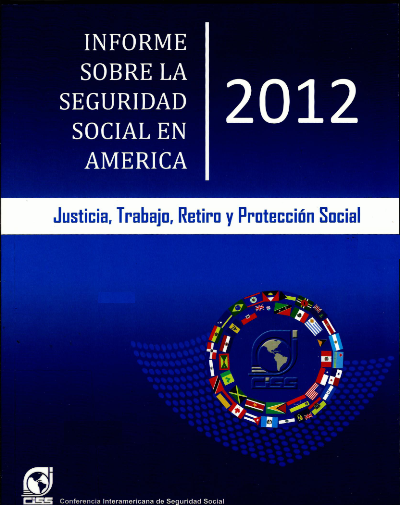
|
|
|
|

|
|
Informe sobre la seguridad social en América 2014: Medición del bienestar
En este Informe se presentará una estrategia de evaluación del bienestar que se centra en la persona y liga la calidad del trabajo con otras condiciones de la vida, y se profundiza en la medición de beneficios de los sistemas nacionales de seguridad social con fines de obtener comparaciones internacionales. En esta ocasión, la medición se centra en los beneficios de invalidez general y de riesgos...
|
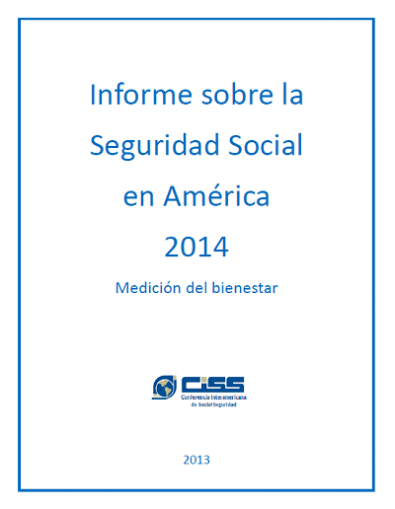
|
|
|
|

|
|
Promised and actual benefits in mexican social security fot rhe transtion generation
Este artículo presenta un conjunto de mediciones de los costos y beneficios reales del plan general de retiro por jubilación proporcionado a los ciudadanos por parte del Sistema Mexicano de Pensiones (SMP), que son necesarias para evaluar las decisiones de los trabajadores en cuanto a la contribución a la seguridad social (es decir, trabajar en el sector formal) y al retiro. El SMP ofrece dos...
|

|
|
|
|

|
|
Review of the 2010 World Health Report. Health system financing
The document that was presented by the World Health Organization (WHO) in February 2011 sets forth a series of proposals to encourage member countries to achieve universal health coverage. These proposals are presented in detail and are based both on world statistics and case
studies.
|
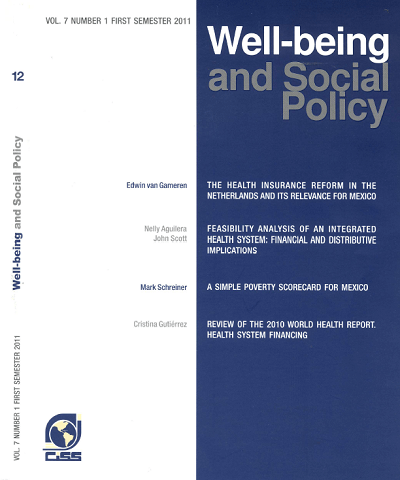
|
|
|
|

|
|
A simple poverty scorecard for Mexico
This study uses Mexico's 2008 National Household Survey of Income and Expenditure to I construct an easy-to-use scorecard that estimates the likelihood that a household has income below a given poverty line. The scorecard uses ten simple indicators that field workers can quickly collect and verify. Poverty scores can be computed on paper in the field in about five to ten minutes. The scorecard's...
|
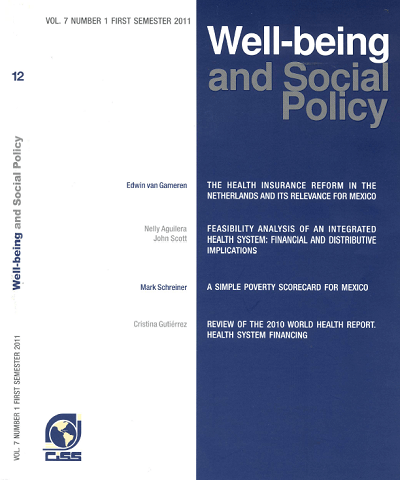
|
|
|
|

|
|
Feasibility analysis of an integrated health system: financial and distributive implications
The document presents spending projections and projections of the distributive incidence for an Integrated Health System under three basic scenarios: status quo, a two pillar scheme (financed through general taxes and private spending) and a three pillar scheme (financed through general taxes, social security contributions and private spending). By presenting these simulations, the study enhances...
|
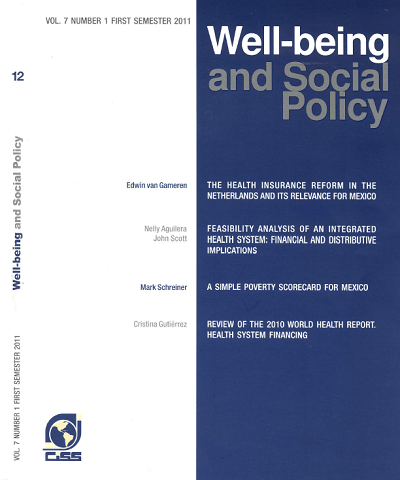
|
|
|
|

|
|
Seguro social de salud
El gobierno de México definió entre los años noventa y los dos mil principios de reforma a los seguros de salud e intentó implementarlos. Las principales iniciativas aprobadas definieron esquemas voluntarios, en un caso basado en aseguradoras privadas (que tienen muy baja penetración), y en otro, en una nueva instancia pública que funciona como mecanismo de distribución del gasto federal hacia...
|
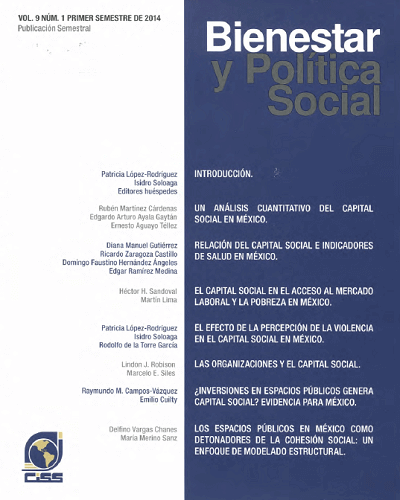
|
|
|
|

|
|
Book review. Violence and social orders: a conceptual framework for interpreting recorded human history, by Douglas C. North, John Joseph Wallis, and Barry R. Weingast
Why societies differ in their level of violence? This is the question addressed by North, Wallis, and Weingast. To provide an answer they must develop a rich theory of how individuals and organizations that compose a human group voluntarily surrender their will to act violently in exchange for participating in a society with improved conditions for the creation and conservation of wealth.
|
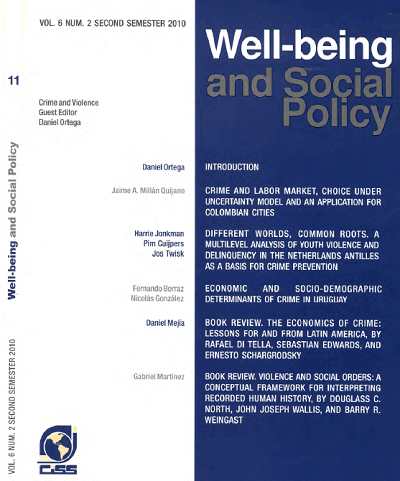
|
|
|
|

|
|
Book review. The economics of crime: lessons for and from Latina America, by Rafael Di Tella, Sebastian Edwards, and Ernesto Schargrodsky
The Economics of Crime: Lessons for and from Latin America makes an important contribution to the study of crime and violence in Latin America and to the debate about what works for reducing crime (and at what cost?). As the title of the book correctly suggests, the book brings together contributions from Latin American economists on the determinants and consequences of crime, as well as...
|
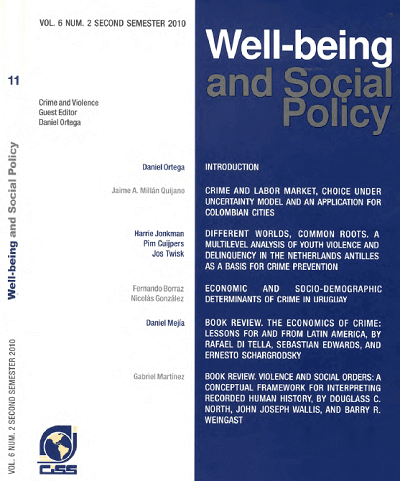
|
|
|
|

|
|
Economic and socio-demographic determinants of crime in Uruguay
This study estimates a panel data model to analyze the economic and socio-demographic determinants of crime in Uruguay across the 19 Uruguayan departments in the period 1986-2006.
This research has two components: i) to present a systematic analysis of the Uruguayan crime data and socio-economic and demographic characteristics of the population, and ii) to evaluate the empirical significance...
|
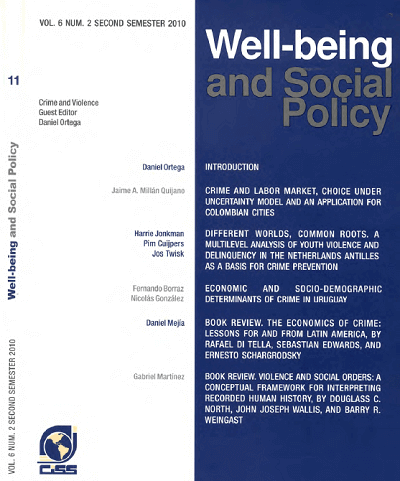
|
|
|
|

|
|
Different worlds, common roots a multilevel analysis of youth violence and delinquency in the netherlands antilles as a basis for crime prevention
Most research on the prevalence, determinants, and variations of violence and delinquency among youngsters is conducted in Western societies. This multilevel study is set in the Netherlands Antilles (NA) and aims to build up prognostic multilevel models as a basis for targeted crime prevention in a non-western area. Data were collected from a sample of adolescente in the NA. Non-hierarchical and...
|
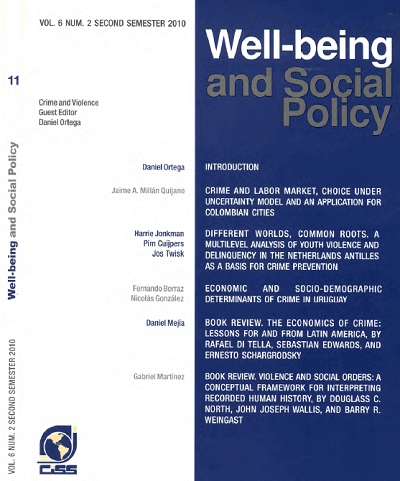
|
|
|
|

|
|
Crime and labor market, choice under uncertainty model and an application for colombian cities
Este trabajo ofrece un modelo para determinar la función de oferta del crimen con base en la teoría de la elección en condiciones de incertidumbre. Con base en el problema de un agente que maximiza su utilidad sujeto a las restricciones del mercado legal e ilegal, este estudio intenta explicar la oferta de la delincuencia como función de la distribución de los salarios y el equivalente cierto de...
|
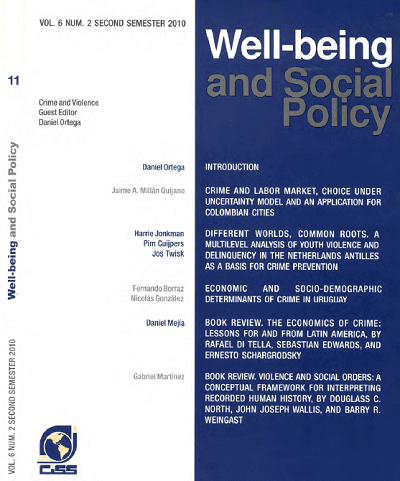
|
|
|
|

|
|
An investigation into the cost of universal health coverage in Mexico
The Mexican social security system, after operating for over six decades, has managed to provide healthcare for slightly over half the resident population.
There are wide geographical and socioeconomic variations in coverage. To provide wider coverage, the Federal Government created the Sistema de Protección Social en Salud (SPSS) for covering low income family. It becomes the third...
|

|
|
|
|

|
|
Informe sobre la seguridad social en América 2010: Seguridad social y mercados de trabajo a lo largo del ciclo económico
Este Informe sobre la Seguridad Social en América trata de la relación entre los ciclos económicos y la seguridad social. No está de más decir que ésta es la principal razón de porqué tenemos seguridad social. Muchos otros objetivos con frecuencia relacionados en el discurso público de pensiones, salud o seguro de desempleo pasan a un segundo plano cuando se trata de cuestiones de pérdida masiva...
|
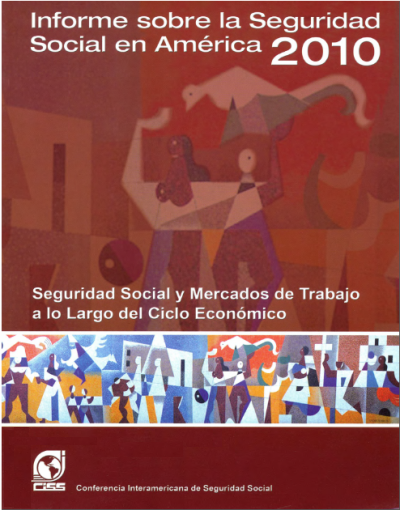
|
|
|
|

|
|
Seguridad social para todos
Folleto de presentación del Programa Seguridad Social para Todos y de los personajes creados para promover los valores y principios de la seguridad social.
|

|
|
|
|

|
|
Persona y sociedad: el papel de la protección social
Este documento forma parte de la serie de manuales de la seguridad social que se han desarrollado en el marco del Programa Seguridad Social para Todos, los cuales tienen el propósito principal de promover los valores y principios de la seguridad social.
|
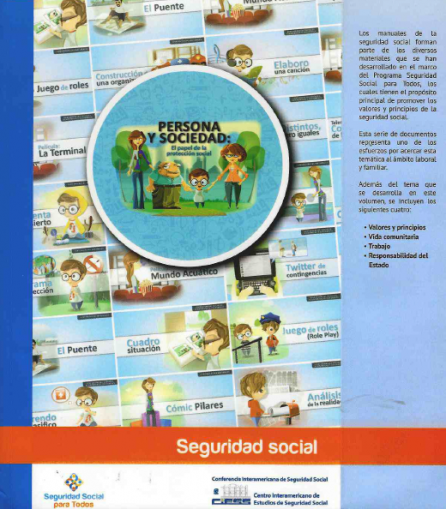
|
|
|
|

|
|
Is international migration a substitute for social security
The focus on short-term macroeconomic factors, including unemployment and wages, is insufficient to explain international migration. Institutional factors, bound to change only in the long run, can potentially have a large impact on migration flows. To illustrate this, we analyze Mexico-U.S. migration focusing on social security coverage, an important indicator of job formality. Using...
|
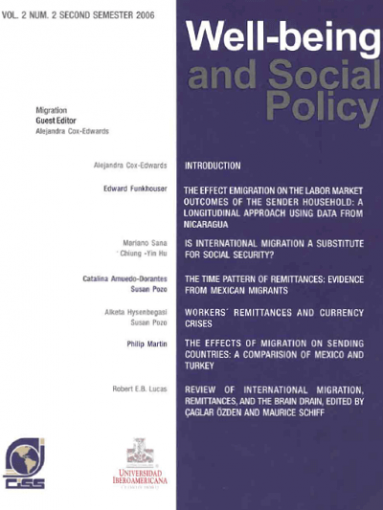
|
|
|
|
|